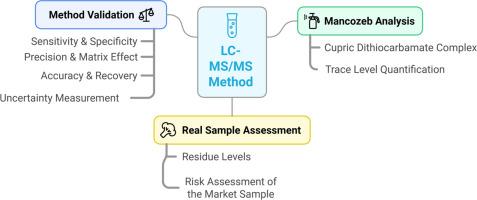Development and validation of a sensitive liquid chromatography-tandem mass spectrometry method for the analysis of Mancozeb residues in cauliflower: Risk assessment of real samples
IF 3.2
引用次数: 0
Abstract
The Dithiocarbamate (DTC) group represents one of the largest consumed fungicides. Presently the most extensively used UV–Visible spectrophotometric method for quantification of DTCs suffers from a lack of sensitivity for trace level detection of residue, poor stability, poor reproducibility, inability to determine LOD, LOQ and chances of matrix interference. In this study a sensitive residue analysis method has been developed and validated for the estimation of dithiocarbamate fungicide, Mancozeb, in cauliflower. Mancozeb was derivatized to a yellow coloured cupric dithiocarbamate complex, which was quantified with mass confirmation by LC–MS/MS. The LC-MS/MS method is considerably more sensitive (LOQ 0.01 µg g-1) than the UV–Visible (LOQ 0.1 µg g-1), specific (unique MRM transitions), accurate (recovery ∼93 %), precise (HorRat ∼0.3 at LOQ), rugged and associated with well acceptable uncertainty. 80 % of the real samples of cauliflower collected contain residues of DTCs above LOQ. Risk assessment of the real sample with the highest DTC contamination (0.18 µg g-1) was conducted. The Theoretical Maximum Residual Contribution (TMRC) of 0.027 mg of Mancozeb/person/day in the Katrain sample was found to be much less than the Maximum Permissible Intake (MPI) of 1.65 mg of mancozeb/person/day and it can be considered safe for human consumption.

菜花中代森锰锌残留的液相色谱-串联质谱分析方法的建立与验证:真实样品的风险评估
二硫代氨基甲酸酯(DTC)是消费量最大的杀菌剂之一。目前应用最广泛的紫外-可见分光光度法在痕量残留量检测中缺乏灵敏度,稳定性差,重现性差,无法确定定量限和定量限,容易受到基质干扰。本研究建立了菜花中二硫代氨基甲酸酯杀菌剂代森锰锌的灵敏残留分析方法,并进行了验证。代锰锌衍生为黄色的二硫代氨基甲酸铜配合物,通过LC-MS /MS进行质量确认。LC-MS/MS方法比UV-Visible (LOQ 0.1µg -1)灵敏得多(LOQ 0.01µg -1),特异(独特的MRM过渡),准确(回收率~ 93%),精确(LOQ HorRat ~ 0.3),坚固耐用,并且具有良好的可接受的不确定性。实际采集的花椰菜样品中,80%的dtc残留量高于限定限。对DTC污染最高(0.18µg -1)的真实样品进行风险评估。在Katrain样品中,理论最大残留贡献(TMRC)为0.027 mg /人/天,远低于最大允许摄入量(MPI) 1.65 mg /人/天,可以认为人类食用是安全的。
本文章由计算机程序翻译,如有差异,请以英文原文为准。
求助全文
约1分钟内获得全文
求助全文
来源期刊

Journal of chromatography open
Analytical Chemistry
CiteScore
2.50
自引率
0.00%
发文量
0
审稿时长
50 days
 求助内容:
求助内容: 应助结果提醒方式:
应助结果提醒方式:


